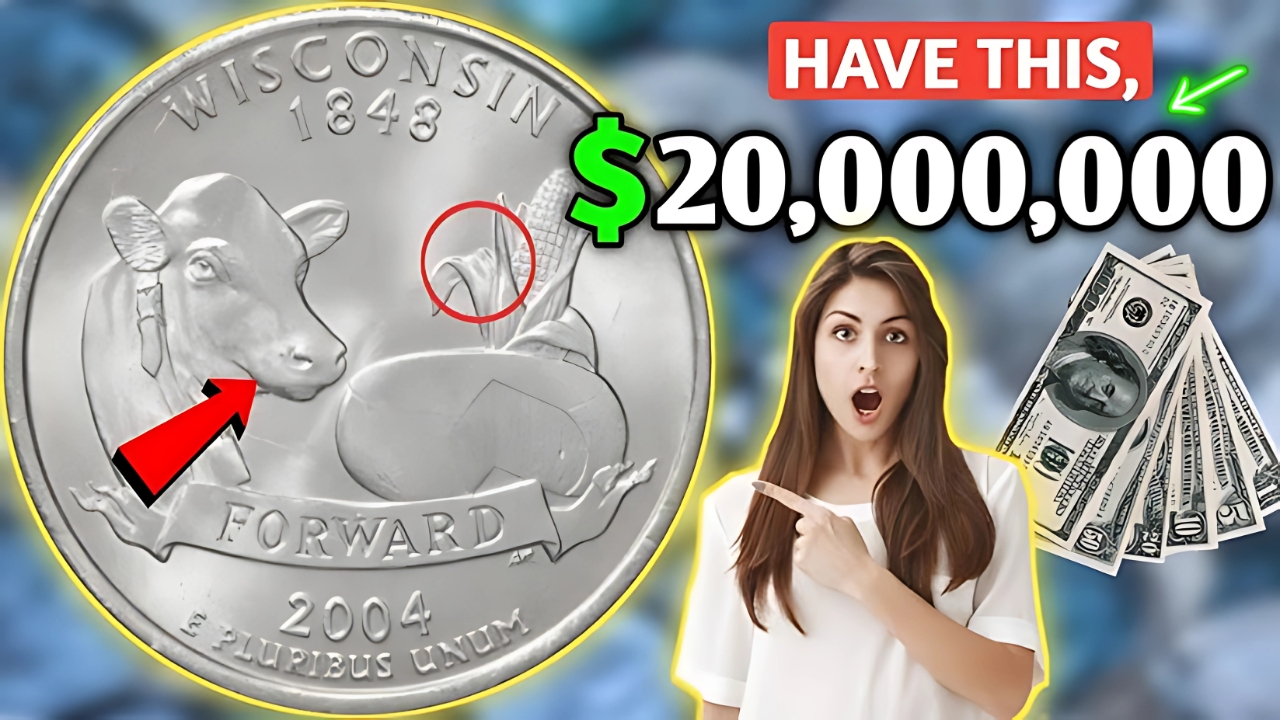What appears to be standard pocket change has transformed into one of America’s Most Valuable Coins A seemingly typical U.S. quarter from 2004 has captured the imagination of coin enthusiasts and casual collectors nationwide, proving that extraordinary treasures often hide in the most ordinary places.
This remarkable transformation stems from an unexpected minting error that occurred during production, creating a collector’s goldmine from what should have been everyday currency. The discovery has sparked a nationwide treasure hunt, with Americans meticulously examining their spare change in hopes of finding this valuable anomaly.
Understanding the 2004 Wisconsin State Quarter Error Most Valuable Coins
Background of the State Quarter Program
The 2004 Wisconsin State Quarter emerged from the highly successful 50 State Quarters Program launched by the U.S. Mint. This initiative honored each state with distinctive reverse designs, replacing the traditional eagle motif that had graced quarters for decades.
Wisconsin’s design prominently featured agricultural symbols representing the state’s farming heritage: a Holstein cow, a wheel of aged cheese, and an ear of corn. However, it was the corn stalk that would ultimately make this quarter legendary among collectors.
The Critical Minting Error
During production at the Denver Mint, an extraordinary mistake occurred. Some quarters were struck with additional corn leaves that weren’t part of the approved design. These extra leaves appeared in two distinct variations:
- Extra Leaf High: An additional leaf positioned higher on the corn stalk
- Extra Leaf Low: An extra leaf placed lower on the corn stalk
Valuation and Market Data
Current Market Values
| Condition | Extra Leaf High | Extra Leaf Low | Regular Quarter |
|---|---|---|---|
| Circulated | $300-$800 | $200-$600 | $0.25 |
| Uncirculated | $800-$1,500 | $600-$1,200 | $0.25 |
| Certified MS-65+ | $1,500-$3,000 | $1,200-$2,500 | $0.25 |
Auction Records and Sales Data
| Year | Grade | Variety | Sale Price | Auction House |
|---|---|---|---|---|
| 2023 | MS-67 | Extra Leaf High | $2,875 | Heritage Auctions |
| 2022 | MS-66 | Extra Leaf Low | $1,950 | Stack’s Bowers |
| 2021 | AU-58 | Extra Leaf High | $1,200 | GreatCollections |
| 2020 | MS-65 | Extra Leaf Low | $895 | Heritage Auctions |
Geographic Distribution and Discovery Patterns
Where These Treasures Surface
Since production occurred at the Denver Mint facility, these error quarters initially circulated throughout the Midwest. However, natural currency movement has distributed them across all 50 states. Recent discoveries have been reported from:
- Primary circulation areas: Colorado, Kansas, Nebraska, Wyoming
- Secondary markets: California, Texas, Florida, New York
- Unexpected finds: Alaska, Maine, Hawaii, Vermont
Identification Techniques
Visual Inspection Methods:
- Examine the corn stalk carefully under good lighting
- Look for extra leaf formations extending from the main stalk
- Compare with standard quarter images from reliable sources
- Use magnification for detailed verification
The Science Behind Coin Error Values
Why Minting Mistakes Create Value
Coin errors command premium prices due to several factors:
- Rarity: Limited quantities escape quality control
- Uniqueness: Each error tells a distinctive story
- Historical significance: Documents minting process failures
- Collector demand: Drives market competition
Authentication and Certification
Professional authentication through services like PCGS or NGC provides:
- Verification of authenticity
- Condition grading
- Market value documentation
- Protective encapsulation
Impact on American Coin Collecting
The Modern Treasure Hunt Phenomenon
This discovery has revolutionized how Americans view their everyday change. The excitement has created:
- Increased public interest in numismatics
- Educational opportunities about minting processes
- Economic benefits for lucky finders
- Community engagement through coin clubs and forums
Educational Value
The Wisconsin quarter error serves as an excellent teaching tool about:
- U.S. Mint operations and quality control
- Currency production and distribution
- Market economics and supply-demand principles
- Historical preservation through coin collecting
Investment Potential and Market Trends
Recent market analysis indicates steady appreciation in value for certified examples. The combination of limited supply and growing collector interest suggests continued strong performance in the numismatic marketplace.
Factors Influencing Future Values
- Condition preservation remains crucial
- Professional certification enhances marketability
- Collector demographics continue expanding
- Media attention drives awareness and demand
What To Do If You Find One
Immediate steps:
- Handle carefully to preserve condition
- Document the find with clear photographs
- Research current values through reputable sources
- Consider professional authentication for valuable examples
- Consult with certified dealers for selling options
Frequently Asked Questions
Q: How can I definitively identify the extra leaf varieties?
A: Compare your quarter directly with high-resolution images from the U.S. Mint or certified coin services. The extra leaves are clearly visible with proper lighting.
Q: What’s the most valuable Wisconsin quarter error ever sold?
A: The highest-graded examples in MS-67 condition have reached nearly $3,000 at major numismatic auctions.
Q: Are other state quarters worth checking for errors?
A: Yes, several state quarters contain valuable errors, including the 2005 Minnesota quarter with extra tree varieties.
The 2004 Wisconsin State Quarter error demonstrates how everyday objects can transform into extraordinary treasures. This phenomenon has reinvigorated American interest in coin collecting while providing real economic opportunities for observant individuals.
Whether you’re a seasoned numismatist or simply curious about the change in your pocket, the Wisconsin quarter story reminds us that valuable discoveries await those who look carefully at the world around them.
